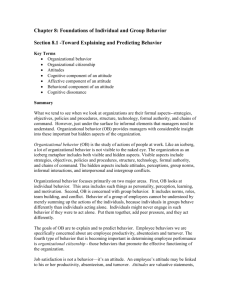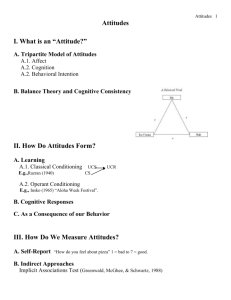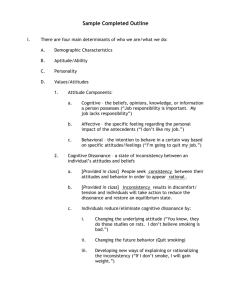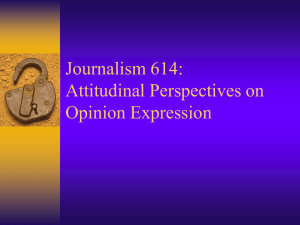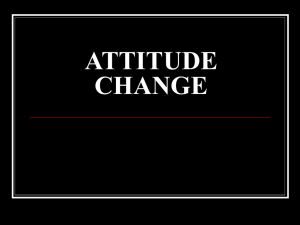Cognitive Consistency Theories of Attitude Change
advertisement
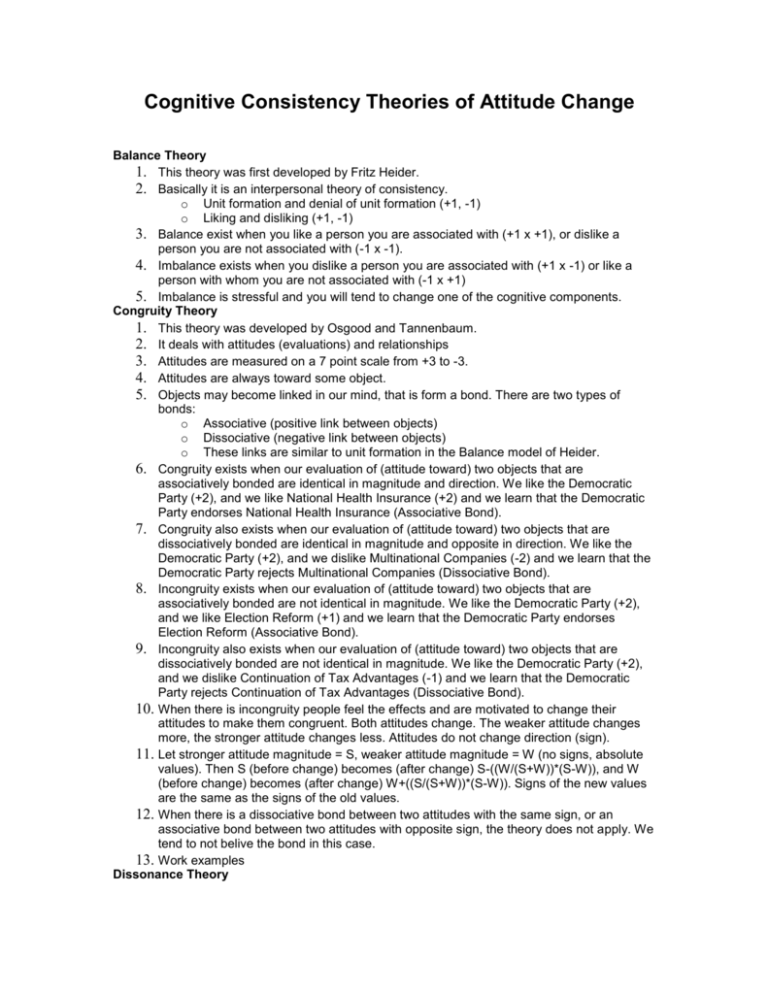
Cognitive Consistency Theories of Attitude Change Balance Theory 1. This theory was first developed by Fritz Heider. 2. Basically it is an interpersonal theory of consistency. o Unit formation and denial of unit formation (+1, -1) o Liking and disliking (+1, -1) 3. Balance exist when you like a person you are associated with (+1 x +1), or dislike a person you are not associated with (-1 x -1). 4. Imbalance exists when you dislike a person you are associated with (+1 x -1) or like a person with whom you are not associated with (-1 x +1) 5. Imbalance is stressful and you will tend to change one of the cognitive components. Congruity Theory 1. This theory was developed by Osgood and Tannenbaum. 2. It deals with attitudes (evaluations) and relationships 3. Attitudes are measured on a 7 point scale from +3 to -3. 4. Attitudes are always toward some object. 5. Objects may become linked in our mind, that is form a bond. There are two types of bonds: o Associative (positive link between objects) o Dissociative (negative link between objects) o These links are similar to unit formation in the Balance model of Heider. 6. Congruity exists when our evaluation of (attitude toward) two objects that are associatively bonded are identical in magnitude and direction. We like the Democratic Party (+2), and we like National Health Insurance (+2) and we learn that the Democratic Party endorses National Health Insurance (Associative Bond). 7. Congruity also exists when our evaluation of (attitude toward) two objects that are dissociatively bonded are identical in magnitude and opposite in direction. We like the Democratic Party (+2), and we dislike Multinational Companies (-2) and we learn that the Democratic Party rejects Multinational Companies (Dissociative Bond). 8. Incongruity exists when our evaluation of (attitude toward) two objects that are associatively bonded are not identical in magnitude. We like the Democratic Party (+2), and we like Election Reform (+1) and we learn that the Democratic Party endorses Election Reform (Associative Bond). 9. Incongruity also exists when our evaluation of (attitude toward) two objects that are dissociatively bonded are not identical in magnitude. We like the Democratic Party (+2), and we dislike Continuation of Tax Advantages (-1) and we learn that the Democratic Party rejects Continuation of Tax Advantages (Dissociative Bond). 10. When there is incongruity people feel the effects and are motivated to change their attitudes to make them congruent. Both attitudes change. The weaker attitude changes more, the stronger attitude changes less. Attitudes do not change direction (sign). 11. Let stronger attitude magnitude = S, weaker attitude magnitude = W (no signs, absolute values). Then S (before change) becomes (after change) S-((W/(S+W))*(S-W)), and W (before change) becomes (after change) W+((S/(S+W))*(S-W)). Signs of the new values are the same as the signs of the old values. 12. When there is a dissociative bond between two attitudes with the same sign, or an associative bond between two attitudes with opposite sign, the theory does not apply. We tend to not belive the bond in this case. 13. Work examples Dissonance Theory 1. This theory was proposed by Leon Festinger, and has generated more research and controversy than any other cognitive consistency theory because of its ability to make non-obvious predictions. 2. Two cognitive elements can stand in relationship to each other as consonant (one implies the other), dissonant (one implies the opposite of the other) or irrelevance (one has no implication for the other) 3. Dissonance is distressful and we seek to reduce it. 4. Magnitude of dissonance is a function of 4.1 Importance of the items: 4.2 The number of cognitive elements involved. 5. Dissonance can be reduced by 5.1 changing the behavioral element. 5.2 change the attitudinal element. 5.3 add cognitive elements consonant with the behavioral element. 5.4 change the importance of the cognitive or behavioral elements.
